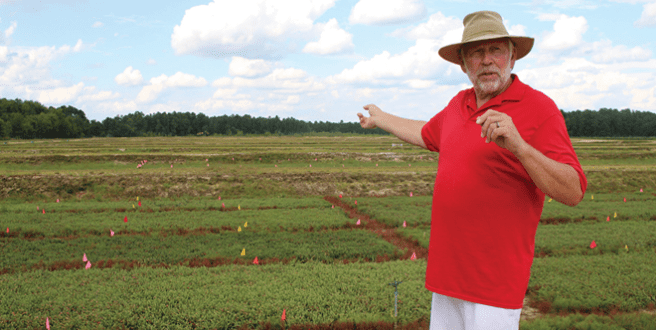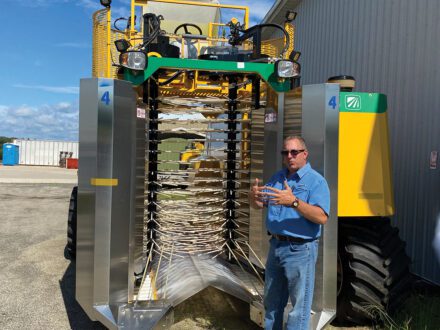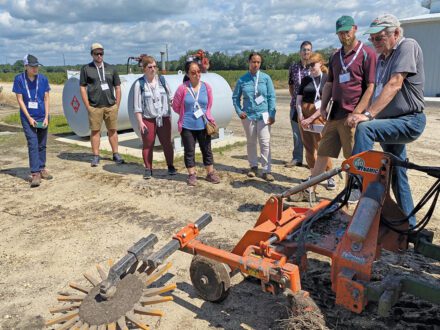

Feb 11, 2024Harvest stars: Berries set the pace in New Jersey
Production trends for blueberries and cranberries were highlighted during the North American Strawberry Growers Association’s 2023 Summer Tour in New Jersey.
Peter Oudemans, director of Rutgers University’s Philip E. Marucci Center for Blueberry and Cranberry Research and Extension, conducted a tour of the substation of the Rutgers’ New Jersey Station in Chatsworth, during the August event.


In addition to leading the fruit pathology program, Oudemans has worked with growers on improved crop management methods and taught classes in agricultural technology and remote sensing.
The center houses USDA, Ocean Spray and integrated pest management programs, Oudemans said, including weed science, entomology, plant pathology and plant breeding.
“We do everything from field trials to DNA sequencing and genetic mapping,” he said.
Blueberry breeding is particularly difficult because there’s so much competition, with private breeders and public institutions releasing new varieties, he said. New Jersey is the birthplace of the highbush blueberry.
The harvesting of wild berries was transcended through the work of Elizabeth White and Francis Colville to a cultivated, domesticated and now highly valued crop that is harvested globally year-round. The work originally was conducted at Whitesbog, New Jersey.
“So, there is a lot of history with blueberries here in southern New Jersey, and it is also the state fruit. Our harvest typically begins in June and continues through July,” Oudemans said.
Some of the new blueberry varieties are remarkable, he said.


The center’s research includes a field that holds five plants of each publicly available blueberry variety ever produced, up to the time Draper was patented.
It can take 10 years or more to produce a viable new variety by propagating it in different areas to get the purity to ensure it doesn’t get infected with any systemic diseases, he said.
“Usually, five years from identification to release is reasonable. We’re getting a lot better at it,” he said. “We’ve got tissue culture techniques out there that can really multiply the plants. And different micropropagation methods where you can take a single cutting and get a lot more plants than you could from one five-inch cutting (are being used).”
Mechanical harvesting
“They are so incredibly tasty, large and firm,” Oudemans said. “They’re amendable to mechanical harvesting, which is a huge factor for blueberry. With hand labor declining, mechanical harvesting is becoming more essential.”
From 1920 until about 1993, production of blueberries increased about 25 pounds per acre, per year, Oudemans said.
“In 1993, something happened,” he said. “It went to 250 pounds per acre, per year. Our increase in production went up ten-fold every year.”
The increase took place when the Duke variety was introduced and was planted in more acres.
“That kind of correlates with that production change. We topped out somewhere around 7,500 pounds per acre, per year.”
Technology advancements led to significant shifts in blueberry production levels — but not an increase. Instead, around 2016, yields began dropping by about 350 pounds per acre each year. The dramatic change can be traced to the increase in mechanical harvesting.


“Each of those large, ride-on mechanical harvesters are pretty pricey,” Oudemans said. “People won’t buy 10 of them in one year. As they buy more and more, that (production) loss increases because there’s more implementation of the harvester.”
A rough estimate is a loss of 30% for mechanically harvested berries, he said, compared to hand harvesting.
Cranberry advancements
Germplasm — the seeds, plants, or plant parts useful in crop breeding, research and conservation efforts — also is a major focus in Philip E. Marucci Center’s renowned cranberry research.
A big emphasis is placed on developing fungal-resistant varieties.
“This has been incredibly important because we’re losing some of our base pesticides,” Oudemans said. “As those products are eliminated I think our shelf life on some of our major materials is five more years. After that we’ll have nothing to control the disease.”
One of the facility’s bogs has cranberry germplasm “from all over the continent,” he said. One of the center’s cranberry projects is phenotype discovery, with two researchers dedicated to the concept of high-throughput phenotyping.
“We’re trying to develop methods to look at different phenotypes, which is how fast things color up, leaf size,” Oudemans said. “Those are kind of mundane phenotypes. We’re only interested in what kind of chemicals they’re producing. That includes biochemicals produced by the cranberry, (chemicals) that help things like urinary tract health, oral hygiene, different things like that.”
He said the field is dedicated to wild selections from throughout North America to see how they do in New Jersey and what kind of characteristics they have.
“We’re using drone imaging for some of it to look at flowering time, berry size and enlargement.”
Fruit rot is a problem in New Jersey cranberry production, and is a major research focus. In addition, red root, a weed that attracts Canada geese that feed on the roots in the water, creating large divots in the cranberry bed, is a target for control strategies.
Gary Pullano is a Michigan-based journalist with more than 45 years of industry experience. As a semiretired former managing editor for Great American Media Services, Pullano has covered the specialty agriculture sector for the past decade. He can be reached at [email protected].
Top photo: Peter Oudemans, director of Rutgers University’s Philip E. Marucci Marucci Center for Blueberry and Cranberry Research and Extension, outlines cranberry research work.














